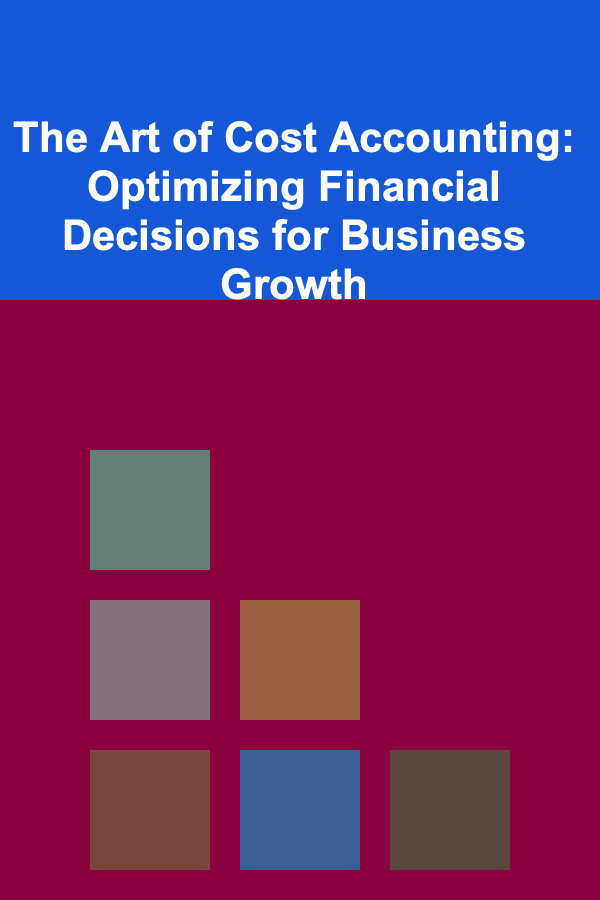
The Art of Cost Accounting: Optimizing Financial Decisions for Business Growth
ebook include PDF & Audio bundle (Micro Guide)
$12.99$11.99
Limited Time Offer! Order within the next:

Cost accounting is not just a routine financial task; it is an essential practice that can profoundly impact the strategic direction and growth of a business. In today's fast-paced and competitive business environment, where financial decisions can make or break an organization, understanding and applying cost accounting principles is crucial for business leaders, accountants, and managers alike. This guide dives deep into the art of cost accounting, highlighting its role in optimizing financial decisions and driving sustainable business growth.
Understanding Cost Accounting
Cost accounting is a branch of accounting that focuses on capturing and analyzing the costs associated with producing goods or providing services. Unlike financial accounting, which serves to report a company's financial status to external stakeholders, cost accounting is primarily used internally by managers and decision-makers to control and optimize business operations. It provides vital insights into where money is being spent, enabling businesses to make informed decisions that improve profitability and efficiency.
The Core Objective of Cost Accounting
The primary objective of cost accounting is to track, allocate, and control costs. By understanding the costs of production and operations, businesses can:
- Control Expenses: By identifying areas where costs are excessive or inefficient, companies can implement measures to control or reduce them.
- Price Products Effectively: Accurate cost information enables businesses to set prices that ensure profitability while remaining competitive in the market.
- Optimize Resource Utilization: Understanding the cost structure helps businesses allocate resources more efficiently, maximizing the return on investment (ROI).
- Make Strategic Decisions: With clear insights into costs, businesses can make data-driven decisions regarding production methods, outsourcing, expansion, and more.
Key Cost Accounting Methods
The process of cost accounting involves several methods that businesses can choose based on their operations, the nature of their industry, and their strategic goals. The primary cost accounting methods include job order costing , process costing , and activity-based costing (ABC). Each of these methods has its own set of advantages and is suited to different business environments.
1. Job Order Costing: Tailoring Costs to Specific Projects
Job order costing is used by companies that produce customized products or services tailored to individual customer orders. This method assigns costs to specific jobs or projects, making it ideal for industries such as construction, custom manufacturing, and consulting.
How It Works:
- Direct Materials: The costs of materials directly associated with each job.
- Direct Labor: The wages and benefits of employees working directly on the job.
- Overhead Costs: Indirect costs allocated to the job based on pre-determined rates or cost drivers (such as labor hours or machine hours).
The Art of Applying Job Order Costing:
- Ensure accurate tracking of time and materials for each job to prevent cost misallocation.
- Use job cost sheets to capture all relevant costs associated with each project.
- Monitor job progress and cost overruns regularly to adjust pricing and timelines.
2. Process Costing: Simplifying Costs in Mass Production
Process costing is used in industries where products are produced in large volumes and are homogeneous in nature. It is particularly suited for industries such as food processing, chemicals, and textiles, where each product is similar and produced through a continuous manufacturing process.
How It Works:
- Costs are accumulated by department or production process rather than by individual job.
- Total production costs are divided by the number of units produced to determine the per-unit cost.
- This method is typically used when products are identical and produced in large batches.
The Art of Applying Process Costing:
- Ensure accurate allocation of costs to each department and process stage.
- Regularly review production costs to identify areas for improvement or efficiency gains.
- Use techniques like FIFO (First In, First Out) or weighted average to allocate costs in a way that reflects production flow.
3. Activity-Based Costing (ABC): Precision in Cost Allocation
Activity-based costing (ABC) is a more sophisticated method that assigns costs to specific activities rather than departments or products. ABC is particularly effective in organizations with complex operations where overhead costs need to be allocated more accurately.
How It Works:
- ABC identifies activities (e.g., machine setup, quality inspections, and customer support) and allocates costs based on the consumption of resources by each activity.
- Each product or service is then assigned a portion of the costs based on how much it consumes each activity.
The Art of Applying Activity-Based Costing:
- Identify and define the key activities that consume significant resources within the organization.
- Determine the most appropriate cost drivers (e.g., machine hours, number of inspections) to allocate overhead costs accurately.
- Use ABC data to identify inefficiencies, reduce waste, and optimize operational processes.
Key Principles for Cost Control
Regardless of the costing method used, the ultimate goal of cost accounting is to control and optimize costs. Here are some essential principles that businesses can follow to ensure effective cost control:
1. Breakdown of Fixed and Variable Costs
A key aspect of cost accounting is the differentiation between fixed costs and variable costs. Fixed costs remain constant regardless of the level of production (e.g., rent, salaries), while variable costs fluctuate based on production levels (e.g., raw materials, direct labor). Understanding these distinctions helps businesses:
- Scale Production Effectively: Fixed costs don't change with production, so scaling up production can lead to cost efficiencies.
- Monitor Profit Margins: By closely tracking variable costs, businesses can adjust pricing and production methods to maintain healthy profit margins.
2. Cost-Volume-Profit (CVP) Analysis
Cost-Volume-Profit analysis is a powerful tool that helps businesses understand how changes in costs, sales volume, and prices affect profitability. The CVP formula is:
Profit=(Sales−Variable Costs)−Fixed CostsBy using CVP analysis, companies can determine their break-even point, identify the sales volume needed to cover costs, and assess the impact of different pricing strategies or cost structures.
3. Setting Standard Costs and Benchmarking
Standard costing involves setting predetermined costs for materials, labor, and overhead, based on historical data or industry averages. These standards act as benchmarks, allowing companies to:
- Evaluate Performance: By comparing actual costs with standard costs, companies can identify cost variances (e.g., material price variances, labor efficiency variances).
- Implement Corrective Actions: If actual costs exceed the standard, businesses can investigate the causes and implement corrective actions to reduce inefficiencies.
4. Lean Costing
Lean costing focuses on eliminating waste within production processes. This method is closely tied to lean manufacturing principles, which emphasize maximizing value while minimizing waste (non-value-added activities). The goal of lean costing is to:
- Identify Non-Value-Added Activities: Eliminate processes that do not directly contribute to the final product or service.
- Streamline Operations: Continuously improve workflows to reduce time and material waste.
- Reduce Costs: By removing inefficiencies, companies can lower production costs while maintaining quality.
Making Strategic Decisions with Cost Accounting Insights
Cost accounting provides more than just a snapshot of current expenses; it serves as a powerful tool for making strategic decisions that propel business growth. Here are some key ways cost accounting can optimize financial decisions:
1. Pricing Strategy Optimization
A solid pricing strategy is central to business success. Cost accounting ensures that businesses set prices that cover both fixed and variable costs while ensuring a reasonable profit margin. By understanding the true cost of production, businesses can:
- Set competitive prices without underpricing or overpricing.
- Implement tiered pricing based on production costs or market segments.
- Offer discounts or promotional pricing based on cost structures to maintain profitability.
2. Outsourcing and Make-or-Buy Decisions
Cost accounting provides the data needed to make informed outsourcing decisions. When evaluating whether to produce in-house or outsource a particular process, businesses can:
- Compare the cost of internal production (direct and indirect costs) with the cost of outsourcing.
- Consider long-term strategic goals, such as maintaining control over quality, intellectual property, or customer relationships.
3. Capital Investment Decisions
When making significant capital investment decisions (e.g., purchasing new machinery or expanding operations), cost accounting offers insights into the potential return on investment (ROI). By analyzing the expected costs and savings associated with an investment, businesses can determine:
- The payback period for an investment.
- The impact on profit margins and cash flow.
- Whether the investment aligns with the company's long-term financial goals.
Leveraging Technology in Cost Accounting
The role of technology in cost accounting has grown significantly in recent years. With the advent of Enterprise Resource Planning (ERP) systems, cost accounting software , and cloud-based solutions, businesses can now access real-time cost data, automate routine tasks, and make more informed decisions. Key benefits of technology in cost accounting include:
- Automation of Routine Tasks: Tasks such as data entry, cost allocation, and report generation can be automated, reducing errors and saving time.
- Data Visualization: Modern tools provide visual representations of cost data, making it easier for decision-makers to understand trends and variances.
- Real-Time Insights: Cloud-based solutions allow businesses to access cost information in real-time, enabling quicker responses to changes in production or market conditions.
Conclusion
Cost accounting is more than just a set of numbers---it's a strategic tool that drives business success. By mastering the art of cost accounting, businesses can make informed financial decisions, optimize resources, and ultimately drive sustainable growth. From choosing the right cost accounting method to leveraging technology, companies that embrace cost accounting principles gain a competitive edge in the marketplace, ensuring they remain agile and responsive to changing conditions while maximizing profitability. The ability to manage and control costs is not just about cutting expenses---it's about making smarter, data-driven decisions that empower the organization to grow, innovate, and thrive.

Building Strong Relationships: Customer Service Excellence in Technical Support
Read More
How to Choose the Right Flooring for Your Renovation
Read More
How to Create a Checklist for Securing Auction or Raffle Items for Your Fundraiser
Read More
How to Plan Budget-Friendly Travel While Still Earning Money
Read More
How to Save on Laundry and Cleaning Expenses: Simple Strategies for Every Home
Read More
How to Secure Sliding Glass Doors and Windows
Read MoreOther Products

Building Strong Relationships: Customer Service Excellence in Technical Support
Read More
How to Choose the Right Flooring for Your Renovation
Read More
How to Create a Checklist for Securing Auction or Raffle Items for Your Fundraiser
Read More
How to Plan Budget-Friendly Travel While Still Earning Money
Read More
How to Save on Laundry and Cleaning Expenses: Simple Strategies for Every Home
Read More